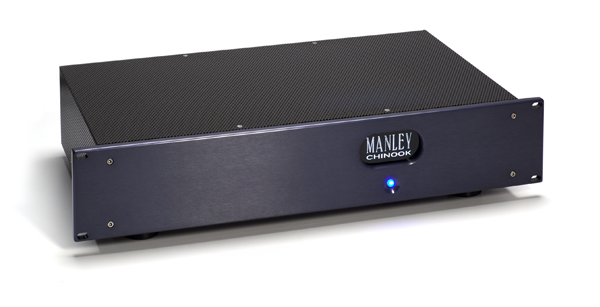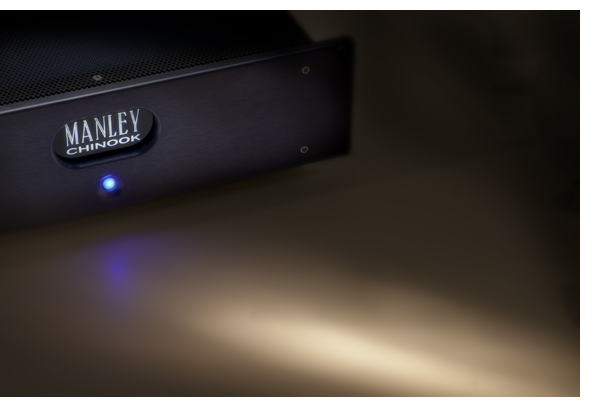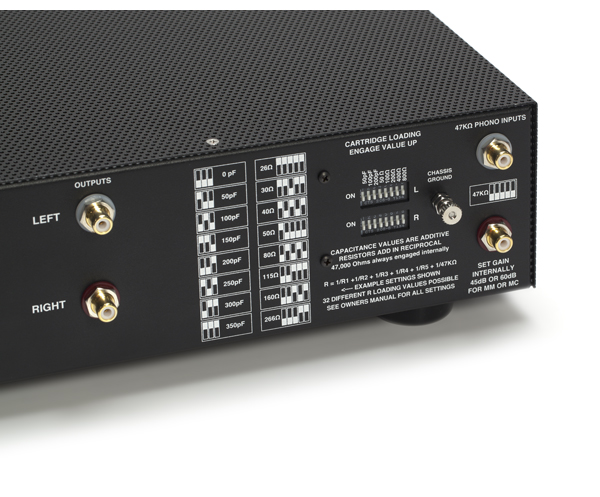Manley Labs Chinook Phono Preamplifier Hook, Line and Sinker
By Lawrence Devoe Around 2005, studio-tube-gear expert Manley Laboratories created an integrated tube amp with an iPod dock for the consumer market that had a triangular shape, and subsequently called it the Stingray iTube, keeping in line with naming the majority of its hi-fi consumer components after sea creatures.
Around 2005, studio-tube-gear expert Manley Laboratories created an integrated tube amp with an iPod dock for the consumer market that had a triangular shape, and subsequently called it the Stingray iTube, keeping in line with naming the majority of its hi-fi consumer components after sea creatures.
“No one’s ever done fish before,” said EveAnna Manley (an avid scuba diver who is often referred to as the “Manley Tube Queen”) in a 2003 interview with Secrets of Home Theater and High Fidelity, regarding the curious decision to name the company’s products after marine life. “Let’s have some fun.”
And Manley keeps the fun going today—in terms of both its product nomenclature and the quality of audio that those products reproduce. Earlier this year, the company launched its “bargain” phonostage, the Chinook, which goes for about a quarter of the cost of its pond mate, an $8,000 statement tube phono preamp called the Steelhead, which wowed vinyl junkies when it hit the market about 10 years ago. As one of TONEAudio’s diehard analog guys, I get my share of vinyl-related products—cartridges, record cleaners, phono preamplifiers and the like—and, while phono fiends like myself still consider the Steelhead to be one of the industry’s best tube phonostages in its price range, the Chinook isn’t a bad catch.
Testing the Water
As I have gotten older, I have grown less tolerant of components that are tricky to install or exhibit quirky operation. Thankfully, the Chinook phono preamp lacks these shortcomings. Its default gain is set at 45 dB, a standard output for moving-magnet (MM) cartridges. If you are a moving-coil (MC) freak like me, you can easily set the gain to 60 dB by removing the perforated cover (affixed with eight screws), flipping a pair of DIP switches for each channel, and replacing the cover. Except for a blue on/standby button under the Manley Chinook logo (which illuminates with start-up), all of the action is on the rear panel, where you will find a ground post, a pair of unbalanced stereo inputs and outputs and dual banks of DIP switches for adjusting capacitance and resistance.
The Chinook offers a staggering 32 loading possibilities all the way up to 47,000 ohms, as well as 24 settings, which yield resistance values below 100 ohms—a setting that’s probably not the best option for most MC-cartridge users. The preamp gives MM-cartridge users seven options for capacitance adjustments, ranging from 50 pF to 350 pF. Manley supplied two pairs of 6922 dual triodes with the review sample, one pair for the gain stage and one for the output stage. Tube rollers can also experiment with pairs of 7308s, 6DJ8s and ECC88s.
Given the Chinook’s $2,250 price tag, I matched it with the most appropriately priced gear available, namely my old standby table: a modified VPI Aries with outboard flywheel and a JMW 10.5i tonearm. For my test cartridges, I used a stereo Clearaudio Stradivari and a mono Benz Micro Ruby 3. Prior to serious listening, I broke in the Chinook a bit by leaving it powered on for 24 hours. (It has a light-bulb-sized appetite of just 42 watts.) Manley recommends placing the Chinook in an area with adequate ventilation, although I noticed that it is only slightly warm during operation. As a side note, this preamp safeguards its tube innards with a gentle 45-second power-up cycle, which helps provide some peace of mind, because there’s nothing more aggravating than blowing tubes at power-up.
The ear party kicked off with Jazz at the Pawnshop (Proprius Records), a live recording from 1976 that features a bunch of plaid-clad Swedes hammering away at American standards. I was immediately struck by the Chinook’s near-holographic soundstage. I then moved on to Chamber Music Society (Heads Up) from bassist-vocalist Esperanza Spalding, on which she plays a snappy duet, “ Inútil Paisagem,” with jazz vocalist Gretchen Parlato. This cut really tests a phonostage’s ability to distinguish between two female voices that continuously alternate parts; meanwhile a discrete acoustic bass provides the backbeat. The Chinook kept perfect pace with the exchange between the vocals and Spalding’s infectious bass line.
Next, I wanted to see how the Chinook handled a recorded pipe organ, which isn’t everyone’s cup of tea, but it does offer an objective lesson in deep bass and, because most are built into large churches, big acoustic spaces. In the 1970s, speaker maker Dave Wilson recorded a series of recitals with organ virtuoso James B. Welch, playing some of the finest pipe organs in the country. One such LP from 1977, simply titled Concert (Wilson Audio), treated me to some of the best renditions of bass and space that I have been privileged to hear, courtesy of the Chinook.
To test it further, I had to see how the Chinook handled mono, because some of the best phonostages can bring life and breath to mono LPs, astonishing those who faintly remember such records playing on their parents’ old phonographs. If you scratch the surface of serious vinyl lovers’ collections, you are likely to uncover these relics, and reissue companies have recently begun releasing some classic LPs from the glory days of yesteryear. One such example is from Julie London, a sexy siren who made it big in the 1950s. She heated up my listening room (in more ways than one) with “Cry Me a River,” from a 45-rpm reissue of Julie is Her Name (Boxstar Records). I then spun the tracks of the iconic bop-era recording, Birth of the Cool (Classic Records), which were laid down between 1949 and 1950 and feature trumpet idol Miles Davis, his big-band arranger Gil Evans and a legendary supporting cast. The Chinook made sure that you heard everyone in the studio with amazing recovery of detail, including some off-mic chatter, which adds a level of authenticity and nostalgia to the listening session
Many, many, many LPs later, the ear party ended with MoFi’s reissue of Little Feat’s Waiting for Columbus, arguably one of the greatest live rock albums of all time. On this record, the late Lowell George and his super-boogie band present dueling synthesizers, guitars, percussion, keyboards and brass, a combination that makes for some hefty tunes. Listening to the opening cut, “Fat Man in the Bathtub,” through the Chinook was a refreshing auditory slap in the face, just like having a primo standing-room-only place right near the stage.
Hooked on the Chinook
Vinyl records can quickly become an addiction that, fortunately, won’t shorten your natural life or get you busted for possession. How you support this habit depends on source selection and, most critically, playback equipment. Choice of turntable, tonearm and cartridge obviously matter, but the delicate signal still has to navigate the rest of the sound chain, where the phonostage acts as the gatekeeper of the grooves. On this front, the Chinook excels, offering a substantial taste of the audio high life without maxing out your credit card. It’s also a versatile component that will appeal to a variety of listeners.
Tube-phobes can relax, as this baby is dead quiet, even when cranked to the max; so can audio newbies, because setting up the Chinook is a cinch. But before rushing out to plunk down more than two large ones, note that maximum gain for MC cartridges is 60 dB, which proved more than enough gain for the cartridges used in this review. Some top-flight cartridges, however, put out less than 0.30 mV, which may not be the best match for this phonostage in a system based around a low gain preamplifier and/or low sensitivity speakers.
In summation, the Chinook provides spot-on imaging and recreation of the original recorded space, along with killer dynamics and a broad frequency spectrum—all at a reasonable price.
 Gone Fishin’ (additional listnening)
Gone Fishin’ (additional listnening)
Before sending the Chinook to Lawrence for this review, I had the pleasure of putting some initial hours on the clock and running it with a few of my own turntables. I auditioned it with everything from the meager Shure M97 to the mighty Lyra Atlas, with excellent result. Nothing in my stable of cartridges has less than 0.4 mV of output, so 60db of gain was more than sufficient.
Having spent a year with one of Manley’s Steelheads, that phono preamp has always been one of my favorites, it has a ton of personality—you’ll never mistake the Steelhead for anything less than a fish of the tubus maxiumus family.
Now compared to the big fish in my current analog pond (the Audio Research Reference Phono 2 SE, the Vitus MPP-201 and the Pass XP-25), the Chinook has a, shall we say, friendlier, more laid-back presentation. But remember, my big-fish phonostages break the bank, with prices ranging from $11,000 to $60,000. Everything else in the Chinook’s price is just StarKist tuna.
Mating the Chinook with the awesome and price-appropriate VPI Classic 1 turntable and the Lyra Kleos cartridge produced a relatively affordable analog front end of about $8,000, which won’t force you to take out a second mortgage. That’s hardly Filet-O-Fish pocket change, but if you can find a heftier helping at this price, please, let us know about it.
The Manley Chinook gets down to the bare essentials, offering high performance in a basic box with no frills—everything you need and nothing you don’t. We are happy to award it one of our Exceptional Value Awards for 2012. —Jeff Dorgay
Chinook Phono Preamplifier
MSRP: $2,250
Manufacturer: Manley Laboratories, www.manley.com
Peripherals
| Preamplifier | “Pass Labs X-30” |
| Amplifier | “Pass Labs XA-100”.5” |
| Speakers | “Martin Logan CLX” |
| Power Conditioner | “Running Springs Audio Dmitri and Maxim” |
| Cables and power cords | “Nordost Valhalla and Odin” |



